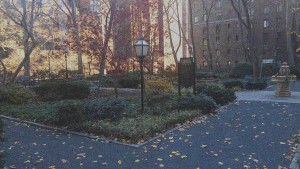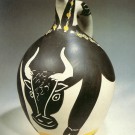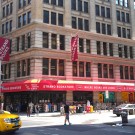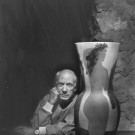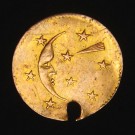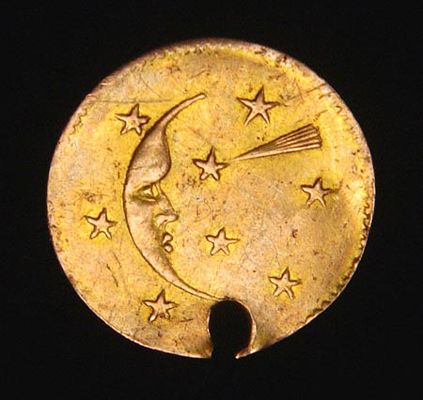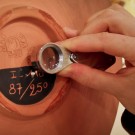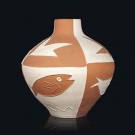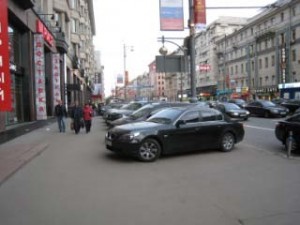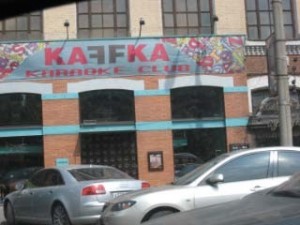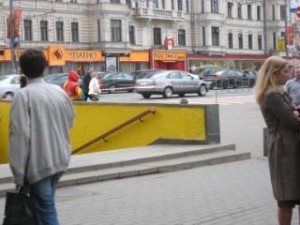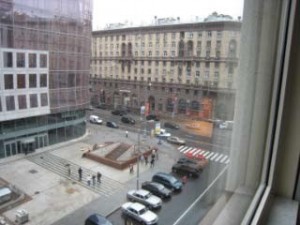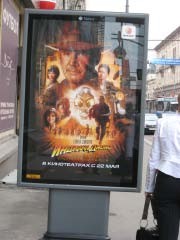Value Mysteries: The Case of the Runaway Picasso Bull
Working at the Madoura Pottery in the village of Vallauris in the South of France Pablo Picasso hand-decorated over four thousand ceramics between 1947 and his death in 1973. Over 600 of these were selected to be replicated in editions of 25 to 500 by the artisans at the Pottery and sold inexpensively to the tourists. For the last thirty some years they have been bought and sold at auctions and in galleries around the world. Studying these sales can bring fascinating insights into markets in general and the art world in particular.
Market inefficiency drives price volatility and, as with many markets, there are three factors that create inefficiency for Picasso ceramics: lack of knowledge, thin trading and what some people might call manipulation but which in reality is simply the interaction of small groups of people who think they are smarter than everyone else seeking to make money by exploiting the first two factors.
Ironically, until recently the highest prices for Edition Picasso ceramics were achieved in the 1980s when the Japanese appeared to be on the verge of taking over the world. At the beginning of the decade it was the Japanese who knew something that everyone else didn’t: that ceramics had always been the true fine art in Japan, a culture where oil painting had not traditionally existed. Tremendous wealth was flowing toward Japan and the Japanese wanted to experience the best that the Old World had to offer in luxury products, fashion, food, entertainment and of course art. Well-heeled Japanese who weren’t rich enough to buy important European paintings could pay twice the asking price for a Picasso plate and feel they had gotten a tremendous bargain. Prices soared. By mid-decade Sotheby’s and Christie’s, which for years had turned up their noses at Picasso ceramics as mere tourist curiosities, began to include them in sales. Prices went even higher. Yet few people understood what these items were, where they were made, who made them and how many were created.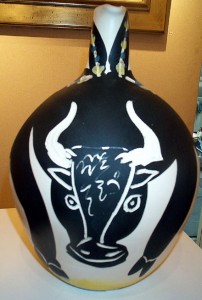
Because Picasso ceramics were low-priced vacation “souvenirs,” there was little published information available. Not even the book written by the owner of the Madoura Pottery, Georges Ramié (which was only available in French for several years), offered much hard data. Georges Ramié’s “Ceramiques de Picasso” pictured various of Picasso’s unique prototypes without explaining that there were perhaps hundreds of “authentic replicas” of the pictured pieces. This inevitably led to confusion among buyers and sellers alike as to whether ceramics were originals or edition pieces (in fact the vast majority of ceramics decorated personally by Picasso were never for sale and are still owned by members of the Picasso family and museums).
When this Bull appeared at auction it was probably the first time that anyone in the prestigious sale rooms had ever seen anything like it. But novelty wasn’t the only reason that this Bull sold at Sotheby’s London on October 18, 1990 for 44,000 British Pounds, then the equivalent of $87, 824. Knowing that the Japanese were voraciously pursuing Picassos a dealer may have made the top bid for this ceramic, figuring he could sell it to some rich fool in Tokyo. It only takes two bidders to achieve a record auction price and unknowingly the buyer might have been bidding against the one Japanese collector who would have paid a top retail price for this ceramic. Or perhaps there was a second dealer who thought he too was smarter than everyone else, was willing to take risks and believed there was no limit to the Japanese mania for Picasso ceramics. We’ll never know. What we do know is 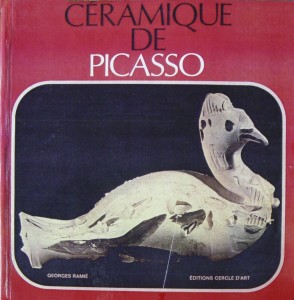 that one month later, on November 19, 1990 another Picasso ceramic Bull just like the first sold for $39,600 at Christie’s in New York City.
that one month later, on November 19, 1990 another Picasso ceramic Bull just like the first sold for $39,600 at Christie’s in New York City.
A 55% decline in one month would be considered a crash in any market (the great Stock Market Crash in 1929 was a mere 12.82%). Certainly one factor in the price decline was lack of information, but that was about to change — sort of. In 1989 Alain Ramié, the son of Georges, published “Picasso – Catalogue of the Edited Ceramic Works.” I say “sort” of because both Georges and Alain Ramié’s books were popularly referred to as the Ramié Catalogue and to this day they are confused with one another. Each gave numbers to the pictures of Ceramics they included but the only Ramié numbers that now mean anything to dealers, collectors and auction houses are the numbers from Alain Ramié’s book. It is an authoritative catalogue raisonne compiled from the records of the Madoura Pottery and includes definitive measurements, descriptions, edition sizes and pictures. Sometimes (but not always) these numbers are referred to as AR numbers. Thus the professional shorthand for this Bull is R 255 or Ramié 255 or AR 255.
Around the time of the record 1990 sale anyone with access to the Alain Ramié catalogue would have known that the Bull was one of an edition of 100. In fact that’s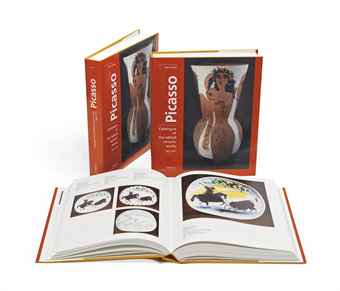 how Sotheby’s identified it in the auction catalogue, but clearly the bidders weren’t aware of or discounted this information. In fact edition size is a problematic fact. After all, it’s not like there are actually 100 of these ceramics available for sale at the time of any given auction — there is only one. It might be years or even decades before another appears for sale (then again, it could be weeks). Of course there’s nothing like a record sale to alert all of the other owners of a similar item that now may be a good time to sell — often gaggles of similar pieces suddenly appear out of the woodwork at the next sale once a record has been achieved.
how Sotheby’s identified it in the auction catalogue, but clearly the bidders weren’t aware of or discounted this information. In fact edition size is a problematic fact. After all, it’s not like there are actually 100 of these ceramics available for sale at the time of any given auction — there is only one. It might be years or even decades before another appears for sale (then again, it could be weeks). Of course there’s nothing like a record sale to alert all of the other owners of a similar item that now may be a good time to sell — often gaggles of similar pieces suddenly appear out of the woodwork at the next sale once a record has been achieved.
In the stock market there are millions of shares, and the “spread” between the bid and ask prices can be a fraction of a penny. However, for thinly traded items the spread can be enormous. In hot markets this may work to the seller’s advantage: you might have multiple bids on your million dollar Miami Beach condo in 2007. But if the buyers suddenly disappear like they did for Florida real estate in 2009 you may have one offer and it might be for $400,000. This is what happened to the artworld when the Japanese “Bubble Economy” burst. The music suddenly stopped, the Japanese buyers disappeared, seemingly from one day to the next. Just as with people holding Collateralized Mortgage Obligations in October 2008, anybody who hadn’t already found a “greater fool” to sell to was stuck.
If the underbidder felt bad about losing the Bull at Sotheby’s October 1990 sale, he probably felt a lot better after the Christie’s sale the next month. And the buyer who bought the Ramié 255 Bull at a 55% discount (perhaps the same underbidder?) may have thought he was a genius. He would have been mistaken. The following year, on November 4, 1991, a Bull sold for $24,200, again at Christie’s in New York, nearly 40% less than the “bargain” November 1990 price. (Of course any dealer with a Bull of his own had immediately raised the price of the one in his shop to at least the $87,000 after the October 1990 Christie’s sale and many never adjusted their price downward — but this will be another post.)
Nearly twenty years later the Picasso Edition Ceramic Bull AR 255 was still changing hands at about the same price it brought in 1991 (one sold at Sotheby’s New York on October 29, 2010 for $25,000).
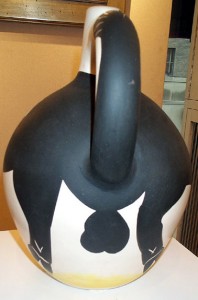 You would think that the market is more efficient these days, wouldn’t you? That lack of information is no longer an issue, that edition sizes have been discounted in the prices, and that mature markets like the long-standing one for Picasso ceramics can’t suffer from small groups of people who think they are smarter than everyone else seeking to make money by exploiting the first two factors.
You would think that the market is more efficient these days, wouldn’t you? That lack of information is no longer an issue, that edition sizes have been discounted in the prices, and that mature markets like the long-standing one for Picasso ceramics can’t suffer from small groups of people who think they are smarter than everyone else seeking to make money by exploiting the first two factors.
How then would you explain the Edition Picasso Ceramic Bull that sold on June 25, 2012, just a year and half after a two-decade string of $25,000 – 35,000 sales, for 97,250 British pounds at Christie’s South Kensington, then equal to $151,263?
I’ll try in my next post.
A Conspiracy of Paper
“A Conspiracy of Paper” was mystery writer David Liss’s first novel, published in February 2000. It’s a meticulously researched story of a Jewish boxer in 18th century England who gets involved in stock market manipulations that have eerie parallels to what goes on in financial markets today.
I bought the book when it first came out because I like the period and am interested in the stock market. Also, I must confess, I was jealous. I was an active mystery writer at that time, and frankly I wanted to know what kind of book a big-deal publisher like Random House would throw its weight behind. “A Conspiracy of Paper” came out the gate with a bang-up review in the Sunday New York Times and ended with an Edgar for Best First Mystery Novel of the year. And in fact it was a great read. At least I consoled myself with the thought that I 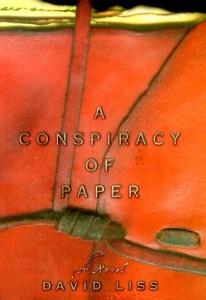 had purchased a first edition (I felt it only right to buy fellow writer’s books, hoping that some of them might follow the golden rule, too), and it would probably be worth something one day. Back then first novels by writers who were hot brought big prices at the many bookstores across America that specialized in mysteries. A mystery writer friend of mine who was practically living out of her car was kicking herself for not having saved a few copies of her first novel which was then selling for almost as much as the advances I received from St. Martins Press.
had purchased a first edition (I felt it only right to buy fellow writer’s books, hoping that some of them might follow the golden rule, too), and it would probably be worth something one day. Back then first novels by writers who were hot brought big prices at the many bookstores across America that specialized in mysteries. A mystery writer friend of mine who was practically living out of her car was kicking herself for not having saved a few copies of her first novel which was then selling for almost as much as the advances I received from St. Martins Press.
Today, sadly, there are few if any mystery bookstores left, and if you want to read “A Conspiracy of Paper” you can for $9.99 download it for your Kindle. But we’re remodeling our small New York apartment and there simply isn’t room for all the books so today was the day that I decided to cash in on my investment.
In terms of dollars, selling your books is orders of magnitude less consequential than selling your stocks or your art, but in certain ways it can offer clearer insight into how markets function. Bookstores and book dealers don’t just make the market for books — they physically OWN the market. Unless you own a bookstore, too, books are virtually unsellable except maybe through Ebay (which for low priced items is more trouble than it’s worth). Luckily in New York City we have the Strand, one of the largest independent bookstores in the world and one that actively purchases books — but strictly on their terms. The Strand is not only prepared but happy to deal with walk-in sellers. Computers allow them to scan the bar code and have instant information about how much they can offer.
Some people might characterize these offers as a conspiracies not of paper, but of spare change. Therein lies the reality of all markets: it is demand that drives prices, not supply. You may have an extremely rare volume, but it doesn’t matter what you think it is “worth.” Yours may be from a tiny edition. The author might be loved by critics and readers alike. You may have seen one in a store for a hundred dollars. None of this matters. The only real question is how many people would buy it if they knew that yours was available for sale? (Perhaps that’s why signed first editions of my mysteries, tiny editions all, linger on Abebooks.com for less than $30.00, but that’s another story.)
If you take your books to the Strand, they won’t even consider anything that isn’t in perfect condition because you probably purchased your books from Barnes and Noble, not Sotheby’s. You don’t have a book collection, you have a lot of used books — and as with used cars or used furniture, a used book has to look pretty good if it’s going to appeal to anybody. The Strand will save you the trouble of shlepping home less than perfect editions — they put them out on the $1 sale tables — but they won’t give you a nickel for a wheelbarrow of them. For books in pristine condition they might pay a few dollars, take it or leave it. Even very nice art books will probably bring less than $10. Again, if you don’t like their offer you can go become a book dealer yourself. Go ahead, try your to sell first edition John Updike on Ebay. According to the Strand, nobody really collects Updike, regardless of how great the New York Times thought his books were — and the press runs were huge so there’s plenty of supply out there. There’s no demand for John Grisham, or most other best-selling authors, either — and the supply is even larger for this stuff. You may point out that booksellers on Abebooks are asking hundreds of dollars for that rare classic the Strand is offering you two bucks for. They will point out that they’ve had six upstairs since 1992, none have ever sold. Why do they need to buy another one at any price?
And those fancy art books? A gallery owner friend of mine bought a few boxes of Chagall catalogues raisonnes when they came out decades ago. Art dealers and appraisers need to buy these essential references so there is a legitimate demand — you can find them one Abebooks for hundreds of dollars. But how many art appraisers are there and how many don’t already have copies? Thirty bucks was all the Strand would offer, and they certainly didn’t want all twenty, the most they might take was one or two. It could take years to sell them and, after all, they already had a few copies.
And David Liss? If you go to Advanced Book Exchange you can find a signed first edition of “A Conspiracy of Paper” in perfect condition for $120. Unfortunately you can also find perfect signed firsts for $10, to say nothing of all the unsigned copies. Publishers support their books to make sales in the primary market, not the secondary one. Random House sent out hundreds of promotional copies, had a national advertising campaign so they could sell enough of that big first printing of Liss’s first novel to make a profit. Everybody thought the author was going somewhere, so plenty of people saved their copies. The Strand already has a ton of them and hasn’t sold one for years. That’s why they didn’t want mine at any price. And I wasn’t going to shlep it home and wait for collecting first mystery novels to come back into fashion.
It will probably be on the $1 table for a long time to come.
Pablo Picasso Ceramic Editions from the Madoura Pottery
In the summer of 1946 Pablo Picasso visited the ancient city of Vallauris in the South of France. The name Vallauris comes from the Latin “Vallis Auris” – Valley of gold, but the gold here was the rich clay of the area. The town became a pottery center in Roman times, producing the amphorae that wine traditionally was stored in.
Two thousand years later Vallauris was still a pottery center, though the sixty-odd workshops of the town were in depressed economic straights after the Second World War. Picasso, who was soon to move to the South of France, admired some of the local ceramic production in Vallauris and amused himself by decorating a few plates. When he returned a year later and was shown the fired results, he was enchanted. Georges and Suzanne Ramié, owners of the Madoura workshop seized the opportunity to invite him to make himself at home at Madoura, putting all of their artisans at his disposal, even giving him an outbuilding to store his production.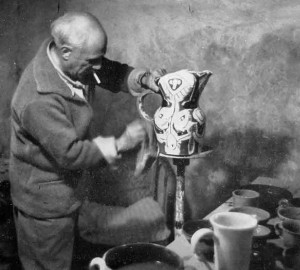
It was a dangerous offer to a man like Picasso, who happily took over the pottery’s entire output. Clearly Madoura couldn’t survive as the personal ceramics studio for Picasso, so it was early on agreed that the Ramiés could produce editions after Picasso’s originals. These “Authentic Replicas” would be sold inexpensively to the tourists, which worked to everyone’s advantage. Picasso could explore this wonderful medium; the tourists could bring home a whole new category of souvenirs from their French vacation; and the local economy would get a much needed boost. Even better for Picasso whose financial success as an artist was the cause of grumbling in the Communist Party which he had recently joined — Picasso could now demonstrate that he was helping labor employment, plus he was making affordable art for the people!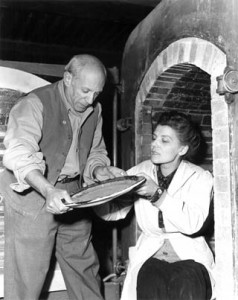
Ultimately Picasso personally decorated over 4,000 ceramics at Madoura, the vast majority of which he kept for himself and which are now in museum collections or still belong to the Picasso family. The artist was also directly involved in the replication by the Madoura artisans of over 600 of his ceramics in editions of between 25 and 500. These were sold at Madoura from 1947 until Picasso’s death in 1973 and what remained continued to be sold until the individual editions sold out. Each ceramic was given an individual reference number in Alain Ramié’s definitive Catalogue Raisonné which everyone now uses for easy identification. The most interesting forms ceased to be available within a few years of their introduction, but Madoura was still marketing leftovers until 2012 when what were said to be the pottery’s “Bon à tirer” collection was sold at Christie’s South Kensington for record prices.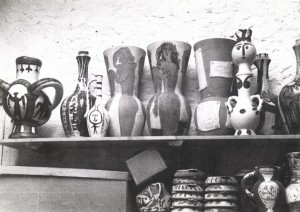
Almost as soon as they became available Picasso ceramics were adored by the public (especially those tourists bringing back Picasso souvenirs). The art establishment, however, was initially convinced Picasso had lost his marbles: the great creator of Cubism was now playing with clay! However, with the 1998 blockbuster exhibition, PICASSO: PAINTER AND SCULPTOR IN CLAY, presented by the Royal Academy of Art and the Metropolitan Museum of Art, Picasso ceramics were acknowledged as some of the artist’s most innovative work. Today items that people’s grandparents paid less than $10 for can sell for tens of thousands. The market in fact is more heated — and prices more erratic — than ever before.
With the total number of Edition Picasso Ceramics approaching 120,000 in number, common sense would suggest that the smallest — and therefore the rarest — editions would command the highest prices. However, some ceramics that were made in editions of 25 have sold for much less than fairly common examples from editions of 500. The reasons why might surprise you.
To understand value and quality in this area takes experience and knowledge. I’ve assembled a lot of both as Director for over twenty years of the Jane Kahan Gallery, one of the first and still one of the most important galleries in the world to specialize in this area. In forthcoming posts I’ll share some of what I’ve learned.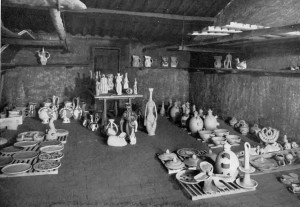
Appraisals, Relativity and Value
Albert Einstein’s Relativity Theory changed the paradigm by which we view the world. Before Einstein people believed in absolute value. After Einstein nothing had an absolute value except the speed of light. If theoretical spaceships had to shrink and time itself had to slow down to make the equations work out, then so be it. Everything was relative. And then quantum theory threw another curve ball by revealing that everything was in the eye of the beholder. Just by looking at something you changed it.
Many people think that appraisals of objects somehow get around Einstein, quantum physics, the Uncertainty Principle and the whole works. They like to think that at least as of the date of the appraisal report, an appraiser can record the absolute value of an object. Unfortunately this is not true. There is no absolute value of a work of art or piece of antique furniture or even money itself, which fluctuates in relation to other currencies, other stores of value and how you measure it.
Take gold for instance. The largest gold coin in the world was produced by the Perth Mint in Australia — one metric tonne of gold, which equals 35,274 ounces. You can find a lot of references to this artifact on the internet and calculations of its “value” (for instance gold at $1300 per ounce makes this coin “worth” more than $45,000,000 US dollars). Presumably the Perth mint will tell you what they want for it if you contact them directly, but I’d be surprised if they’d take the daily bullion cost. This big chunk of change must have cost a lot to produce; there’s bound to be a premium. How much is only one question. Another might be what’s the tab to get it from Perth, Australia, to your apartment in Brooklyn? How about the cost of a new security system? What does it cost to shore up the floor?
Whatever the premium is for a one tonne gold coin I’ll bet it wouldn’t come anywhere close to the premium on this little baby to the right.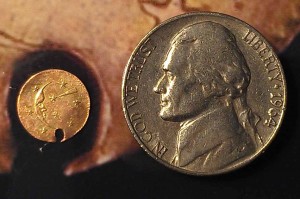 Not the big one — the little fella. This item is what numismatists call a California Gold Token, which was never even legal tender. It also has a hole in it, which usually kills a coin’s value for collectors.
Not the big one — the little fella. This item is what numismatists call a California Gold Token, which was never even legal tender. It also has a hole in it, which usually kills a coin’s value for collectors.
The last time I found a California Gold Token with the Moon and Shooting Star, similarly holed, for sale the price was $799.99. Tokens like these are as thin as a parking ticket and weigh typically about one gram — .035 oz. Most were only 10 karat gold to boot. Even a non-mathematician can see that this bad boy is worth quite a bit more than its weight in gold. By at least one measure (premium above the bullion value of its gold) it is worth astronomically more than the one tonne coin.
But there doesn’t seem to be one of these for sale anywhere in the world right now, so even if you had $45,000,000 you can’t buy it. It’s literally priceless. And even on the day that it was priced at $799.99, its value was relative — worth about a minute’s worth of work for the highest paid CEO in America, Elon Musk, or almost two years’ annual income for the average household in the Democratic Republic of Congo.
Now imagine if Jeff Koons made a ten foot high version of this California token in mirror-polished stainless steel. I don’t know what it would be “worth,” but at Sotheby’s or Christie’s it would probably bring a higher price than the solid gold version. At least this year.
What is an Appraisal and Who Needs It?
When people have a piece of art they want to sell they often think that their first step should be to get an “appraisal” so they won’t be taken advantage of.
But what is an appraisal? When your friend who owns an antique shop says, “This is worth about three thousand bucks,” is that an appraisal? How about when an imperious looking chap wearing a bespoke suit and a British accent looks at your painting on THE ANTIQUES ROADSHOW and declares that it would bring $40,000 – $50,000 at auction? Did you get an appraisal?
The dictionary might say both of these are examples of appraisals, but according to the Appraisal Foundation which was authorized by Congress as the source of appraisal standards and appraiser qualifications, to be credible an appraisal must conform to rules that the Appraisal Foundation refines and publishes every two years in a big fat book entitled the Uniform Standards of Professional Appraisal Practice (USPAP). USPAP compliant appraisal reports can run dozens of pages even for single paintings in order to conform to the standards. To jump through the required hoops takes a lot of hours on the part of the appraiser, so USPAP compliant appraisals are expensive propositions. USPAP says that even oral appraisals must conform to all the myriad standards and be documented in a work file, so it is unlikely that any oral appraisal is USPAP compliant. Members of the professional appraisal associations (the Appraisers Association of America, the American Society of Appraisers and the International Society of Appraisers) all REQUIRE their members to perform only USPAP compliant appraisals.
A person needs a pet grooming license in New York City to shampoo your poodle. To come into your house and do an “appraisal” of your silverware, he doesn’t even need a business card that identifies him as an appraiser. Anybody can give you an “appraisal.” For that matter anyone can issue a “Certificate of Authenticity” for your Picasso, which will be just as credible as the issuing party. The whole point of USPAP and appraisal organizations is to make sure that the public can have confidence in appraisals done by unbiased professionals experienced in the business of valuation – not the business of grooming poodles or selling your property to make themselves a profit.
Bottom line, a credible appraisal is usually a lengthy document conforming to USPAP standards written by a member of a professional appraisal group. If you’re dealing with the IRS for a charitable contribution or for estate tax purposes, chances are you need such a document. Your insurance company may also require it to protect your expensive art collection. Perhaps a credible appraisal is necessary in a court situation — a divorce or a lawsuit.
But if you just want to get some idea of what your art is worth so you can sell it, you very well may not need and probably shouldn’t have to pay for a professional, USPAP compliant appraisal report. So ask your dealer friend for his opinion, run it past an auction house if you like, but be aware that the oral “appraisal” you receive may not be worth the paper it’s written on.
Stephen Hawking Is Not So Smart
The physicist Stephen Hawking said in a famous quote, “I regard the brain as a computer which will stop working when its components fail. There is no heaven or afterlife for broken down computers; that is a fairy story for people afraid of the dark.”
I find this an extremely odd statement, especially from a scientist. It completely ignores what powers the computer, namely electricity. Yes, collections of computer components will not go to heaven. But if a computer dies, does electricity cease to exist?
Whatever “life” is, it has more in comm0n with electricity than with circuitry. When the human body is no longer animated by life, a person dies as surely as the computer on which someone has cut the power. But electricity still exists even when the computer breaks down. When a person dies, isn’t it only logical that life still exists?
Maybe the fairy story is that we are just a collection of organic components.
What makes something valuable?
What makes something valuable?
A long line of discussion usually follows, but at the end it becomes clear that what makes something valuable is the same thing that makes the universe visible: a self-aware mind that can perceive it.
When a tree falls in a forest and there is nobody there to hear it, does it make a sound? Many people in our 21st century materialistic culture will say, yes, it does. But if these people didn’t exist — indeed if no people at all existed, no conscious entities anywhere in our universe, would the universe exist?
Our universe is limited to our perceptions. Flies have a much different view of reality than we do, and in that sense at least they are creating their own reality. But quantum physics indicates that what we perceive as a chair or a cloud or a block of gold are all in fact particles or maybe vibrating strings winking in and out of existence. If we weren’t here, then in a very real sense our universe would not be here either.
Value is the same thing in a parallel way. If we decide that gold is valuable, then it is. If we decide it is worth $200o per ounce that is what it is worth (at least in dollars) though it is exactly the same thing that was worth $500 per ounce a few years ago. The hyper-inflated currency of Weimar Germany was worthless because the German people perceived that it was backed by nothing. When Germany replaced the worthless Papiermarks with new Retenmarks, which it was announced were backed by the sacred soil of Germany, suddenly people perceived that the new currency had value. However, no one was able to take the paper bills to a bank and exchange it for a wheelbarrow of German dirt.
It is the perception, the thought that creates value. This website is about thought.
Appraising Damaged Fine Art Ceramics
Picasso, Chagall, Miro, Leger, Matisse and other important 20th century artists created ceramic works. It could be a serious mistake for appraisers to use the same percentages to assess loss of value to such fine art pieces as some have suggested for damaged decorative art ceramics and porcelain.
Picasso personally decorated over 4,000 ceramics at the Madoura pottery in the town of Vallauris in the South of France from 1947 to 1972. Most never entered the market. However, editions after 633 of Picasso’s designs were recreated by the artisans at Madoura under the artist’s supervision. These “Edition Picasso” ceramics were at first sold inexpensively to tourists, but such pieces became highly collectible over the years. Edition sizes were anywhere from 25 to 500, bringing the total production to almost 120,000 pieces.
It is thus not uncommon for a personal property appraiser to find Edition Picasso ceramics in an otherwise modest home or estate. Such ceramics, which might have been purchased for less than a hundred dollars in the 1950s or 1960s, can be worth tens of thousands today. Large pieces, which are much rarer than the plates, fish, owls and ashtrays that most tourists brought home, can sell in six figures.
The Jane Kahan Gallery has been dealing in fine art ceramics, especially Edition Picasso pieces, since 1973. We have found that this is not a market that focuses on condition. You do not see Dr. No-type collectors at auctions with black lights and fluoroscopes. Repairs and restorations – as long as they are undetectable to the unaided eye – are rarely discussed in galleries or auction houses, though presumably condition reports would be available if requested. Condition is simply not relevant in the same way it might be with stamps or color field paintings or prints where it is of prime importance. If a piece looks damaged or fiddled with, it’s difficult to sell, either at auction or in galleries. If a ceramic looks perfect, however, then professional buyers (who constitute most of the auction market clientele) treat it as good regardless of what may lurk beneath the surface.
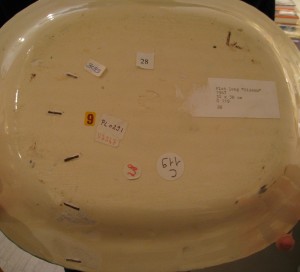 In this litigious society appraisers must therefore be careful with their own opinions, biases and assumptions about condition issues as they relate to fine art ceramics. Regardless of how much an appraiser may believe that condition should affect value, each market has its own realities, which no value formula or guidelines can repeal.
In this litigious society appraisers must therefore be careful with their own opinions, biases and assumptions about condition issues as they relate to fine art ceramics. Regardless of how much an appraiser may believe that condition should affect value, each market has its own realities, which no value formula or guidelines can repeal.
The fact is that perfection was not something that Picasso, nor many other artists, cared about. Picasso cared about the art, he didn’t care about the artifact – a distinction that appraisers reverse to their peril. Picasso never permitted any of his ceramics to be discarded, no matter what their condition issues. There was even a special “mechanic” at Madoura to whom he entrusted the repairs of items that had had firing accidents. We have had at our gallery such a piece, with staples on the back to hold a crack together. This ceramic is pictured in a 1948 magazine with the crack clearly visible. An appraiser inexperienced in the market for fine art ceramics might think this plate is less valuable than a “perfect” piece. Picasso did not think so, nor do many collectors. Nor do we (though we might if it weren’t as attractive and desirable a subject).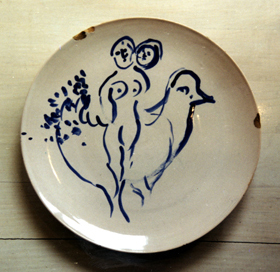
In 1951 Chagall created a dinner service as a wedding gift for his daughter. The family used this service at table. Like Picasso’s ceramics, these plates, saucers, cups and platters were soft earthenware. They chipped. A few such pieces entered the marketplace. The chips are as identifiable as fingerprints and make for a compelling provenance. Do they lessen value? We don’t think so. Repairing such damage might even be seen as compromising its integrity.
An appraiser might assume that condition is more important with Edition Picasso ceramics because they were made in quantities, like prints. This is not necessarily the case. However, when an expensive vase falls off the shelf during an earthquake and shatters into pieces, few would argue that there has been a loss. Assessing this loss can present major challenges and traps for appraisers, especially those inexperienced in this sophisticated market.
Consider this parable into which I have incorporated some auction sales and condition issues of a real Edition Picasso ceramic.
Late in 2003, Helene, a fictitious St. Louis appraiser, is called in by a Dr. No (not the same Dr. No who is so scrupulous about condition) to evaluate a large Edition Picasso ceramic vase that accidentally has been broken into pieces. Rather than waiting until the ceramic is repaired and then consulting with experts in this market to determine its post-restoration value, Helene applies percentages suggested in an industry handbook for catastrophic damage to “modern ceramics.” She declares in her loss/damage appraisal that the vase is a total loss, value zero.
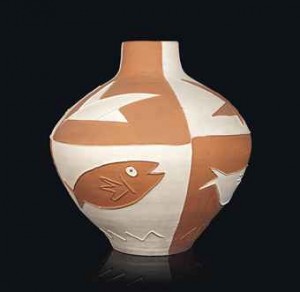 The ceramic in question is Oiseaux et poissons, a large and relatively rare vase, number 291 in Alain Ramié’s definitive catalogue raisonne of the Edition Picasso ceramics. A vase from the same edition of 25 had sold at Christie’s London in October of 2002 for $46,590, so Helene puts down this number as the amount of the loss. (The ceramic would probably have been $65,000 or more in a gallery, but Dr. No didn’t have replacement value insurance.)
The ceramic in question is Oiseaux et poissons, a large and relatively rare vase, number 291 in Alain Ramié’s definitive catalogue raisonne of the Edition Picasso ceramics. A vase from the same edition of 25 had sold at Christie’s London in October of 2002 for $46,590, so Helene puts down this number as the amount of the loss. (The ceramic would probably have been $65,000 or more in a gallery, but Dr. No didn’t have replacement value insurance.)
The insurance company takes possession of the shards and has the vase skillfully restored. It then sends it to Sotheby’s in New York, where it goes into a April 2004 sale and sells for $30,000. Already one can see that, by any definition, the “value” of the ceramic is significantly more than zero. In fact Sotheby’s gave it a presale estimate of $40,000 to $60,000, so it is clear that Sotheby’s didn’t seem to care overly that the piece has been repaired (though the words “skillfully restored throughout” are placed into the catalogue entry).
The buyer promptly sends the ceramic to Christie’s London, where it is estimated at ₤20,000 to 30,000 (roughly equivalent to the $40,000 to 60,000 Sotheby’s estimate) and made the cover lot for an October 2004 sale. This time no off-putting mention of restoration is made in the catalogue, but the ceramic does not sell. Note that when Sotheby’s mentioned condition in the catalogue, the piece sold. This time no mention was made, and the piece did not sell.
Condition information is not generally recorded in on-line databases, so potential buyers looking up the auction records for this ceramic wouldn’t have known about the condition of the piece unless they asked for a report from Christies. Few professional buyers of Picasso ceramics are concerned enough to do this, as I have said before. Someone checking the auction databases, however, would have noticed that the last sale of this ceramic was for $30,000, so perhaps the estimate might just have seemed too high for savvy buyers.
In any case Christie’s puts the piece in the April 2005 auction and lowers the estimate to ₤15,000 to 20,000. This seems to do the trick, because the totally restored ceramic sells for ₤31,200 (then $58,646.) to a French dealer, Monsieur Yes (whom I have made up entirely out of whole cloth, as I have the rest of this story, except for the auction
records for this ceramic and its condition issues, which are real). Monsieur Yes has decades of experience with Picasso ceramics. Condition problems are irrelevant to him unless there is a visible problem, which is not the case here (and if there were a visible problem, he would have it repaired). He takes the ceramic back to Paris and subsequently sells it to an American tourist for the equivalent of $125,000 (they get very good retail prices in Paris). He does not disclose that there is restoration because, not having asked for a condition report, he does not know. And even if he did know, in his experience this is not relevant to the value of the ceramic.
The buyer, Mrs. Maybe, proudly ships her prize back home to St. Louis, and early in 2006 she engages Helene the Appraiser to assess the replacement value of her belongings for insurance purposes. Edition Picasso ceramics are numbered, and Helene cannot help but notice that the number of Mrs. Maybe’s Oiseaux et poissons is the same as Dr. No’s. It is the same ceramic.
What dollar value should Helene assign in her appraisal? Two years ago Helene herself had declared this piece worthless. Its fair market auction value of record is $58,646 from the Christie’s sale. Its retail replacement value is the $125,000 for which Mrs. Maybe recently purchased it in Paris – in fact another vase of this type probably could not be found at that point for any price. Similar to Schroedinger’s Cat from quantum physics which found itself in the peculiar position of being both alive and dead at the same time, Mrs. Maybe’s ceramic appears to be simultaneously both worthless and overpriced.
Helene feels ethically bound to disclose the issue of condition of this vase to Mrs. Maybe, but she should think very carefully before she does so. Monsieur Yes does art fairs in New York, Los Angeles and Miami, and he can’t afford to have integrity impugned. He may very well sue if Helene tells Mrs. Maybe that he has sold her a worthless vase for $125,000.
Good luck with your appraisal, Helene.
Copyright @ by Charles Mathes
Mathes Missive From Moscow #1 – The Cast of Characters
Greetings, Fellow Traveler,
As you may know, my gallery is exhibiting this year for the first time at the Moscow World Fine Art Fair.
Such an endeavor might sound exciting to you. Quarterbacking for New York Giants probably sounds exciting to a lot of people. But if you’re the one who is holding the football as a bunch of guys the size of refrigerators charge toward you at full speed, different emotions may well up. The folks who ride in metal boxes atop rockets into outer space, or play leads in Broadway shows, or make billion dollar bets on oil futures probably feel more scared shitless than excited, too.
Being a writer, I like to think that I can get some perspective and process certain unpleasant emotions by putting things down on paper. It may not actually help, but it gives me the illusion of doing something constructive. And at least there will be a record of what happened in case I am never seen again. I am more scared right now than excited  for reasons that will never become fully apparent. As an art dealer I have to keep everything confidential. The art business runs on secrecy. I’ll discuss this in more detail later (but unfortunately I will not be able to tell you the actual details).
for reasons that will never become fully apparent. As an art dealer I have to keep everything confidential. The art business runs on secrecy. I’ll discuss this in more detail later (but unfortunately I will not be able to tell you the actual details).
Perhaps you have noticed by now a certain sentence structure polish and lack of hysteria that doesn’t quite jibe with the juicy terrors I have been implying are in store. This is because I am composing this ahead of time in New York and plan to send it before we leave on the afternoon of Monday, May 19th, 2008. We will arrive in Moscow at 10:00 a.m. on Tuesday (Moscow is 8 hours ahead of the Eastern U.S.) The Special Invitational Charity Preview to the opening night Gala Opening Night takes place on Monday, May 26 (we are invited, but we would have to buy a table for 10,000 Euros if we wanted to come to the sit down dinner with Mme Medvedev), so we have a week to explore Moscow and set up our booth before the oligarchs descend upon us with their billions. The fair closes on Monday, June 2nd.
Who exactly is the “we” to which I am referring? Allow me to introduce the cast of characters. There are three of us, not including a special cameo guest appearance, which will be revealed in Moscow. Me, you know. At least you thought you did until you wade a bit deeper into these narratives and discover the horrifying extent of my neuroses (you may also not be aware that I was once a member of the National Rifle Association).
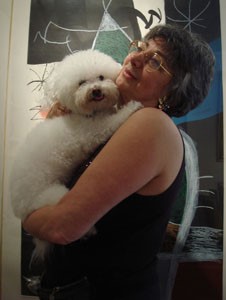 The true heroine of this adventure is our fearless gallerist, Jane.
The true heroine of this adventure is our fearless gallerist, Jane.
Every business must have an engine, and Jane is ours (it was her inspiration to go to Moscow). She’s an explosion of creativity, exuberance, experience, daring, shrewdness, knowledge, vision and a perhaps just the teeniest bit of lunacy. The problem with explosions is that they tend to blow things up, which is where I come in. An explosion by itself isn’t necessarily the best thing to have around, but if you figure out how to put an internal combustion engine around it, you can drive to Schenectady. I try to figure out how we can channel some of Jane’s creatively exploding limitless energy. I must have succeeded a little bit since 1) the East Coast is not a smoldering ruin, and 2) we are about to invade Russia — a formidable exercise in logistics (but one that didn’t work out so well for either Napoleon or Hitler). And you wonder why I’m a little nervous?
In recent years Jane has found her true calling as a photographer of small living creatures. These are mostly dogs, but Jane has also stopped traffic to digitally capture cats, horses, donkeys, ducks, geese, pigeons, wolves and assorted others (even some humans). Hopefully, she will be bringing her camera to Russia.
But, how — you may ask — do we propose to sell artwork in a country where we don’t even speak the language? And who will protect us if we get into trouble? This leads us to the third member of our little team: Julia.
The lighting was a little low here in the Turkish restaurant where she was performing her belly dancing act that night, but you may still be able to tell that Julia is in very good physical shape. Besides being an expert in all manner of gypsy exotic dancing (don’t get any wrong ideas, those are knives in her hands),  Julia is also a personal trainer. Jane signed up with her at the JCC and Julia was such a good personal trainer that it nearly killed her. Julia is also a world-class simultaneous translator (she was born in Ryazan, Russia and went to University in Moscow, majoring in English which she now speaks fluently). If her passion weren’t dance, she would probably be a supreme court justice or a nuclear physicist — she’s that smart (though she eats like a bird). Julia will be coming to Moscow as our assistant, translator and tour guide. (She actually looks much less menacing without her mask and knives, which presumably she will not attempt to bring in her carry-on bag; you will have to wait for the next Missive to see her unmasked.)
Julia is also a personal trainer. Jane signed up with her at the JCC and Julia was such a good personal trainer that it nearly killed her. Julia is also a world-class simultaneous translator (she was born in Ryazan, Russia and went to University in Moscow, majoring in English which she now speaks fluently). If her passion weren’t dance, she would probably be a supreme court justice or a nuclear physicist — she’s that smart (though she eats like a bird). Julia will be coming to Moscow as our assistant, translator and tour guide. (She actually looks much less menacing without her mask and knives, which presumably she will not attempt to bring in her carry-on bag; you will have to wait for the next Missive to see her unmasked.)
So, thank you very much for listening, and this ends our introduction. If you want to find out more about the art fair the way the organizers wish for it to be perceived, go to www.moscow-faf.com A more interesting story (and one with a happy ending, I hope) will take place here. Next stop – Russia.
Nostrovia!
Charles
Copyright © by Charles Mathes
Mathes Missive From Moscow #2 – Tuesday: Arrival
Greetings from Moscow.
I stumbled down to breakfast this morning, not really sure what day it was (it turns out to be Wednesday). Hopefully this will be my worst mistake today — breakfast that is. I knew they had some expensive buffet, but I chose (wisely, I thought) the continental. I still hadn’t figured out the money conversion, so it wasn’t until I got back to my room and looked it up on line did I discover that the 680 rubles i just paid for coffee, croissant and orange juice (18% gratuity included) actually comes to over $28!
We arrived in Moscow yesterday some time between 1:00 and 2:00 pm after a predictable four hour flight delay. I’m not sure of the time, because after the kind of sleep you get on airplanes I was in pretty sorry shape and there was then the predictable problems of getting through customs and finding the car we had hired to take us in from the airport. It was encouraging to find in the airport area beyond passport control two young ladies (whom a cynic might describe as being of the Bialystock-and-Bloom persuasion) in a little booth advertising the Moscow World Fine Art Fair (there were other little booths advertising Lowenbrau and other available delights of the city – Moscow is pretty littered with little booth advertising; billboards of every persuasion decorate the city).
sorry shape and there was then the predictable problems of getting through customs and finding the car we had hired to take us in from the airport. It was encouraging to find in the airport area beyond passport control two young ladies (whom a cynic might describe as being of the Bialystock-and-Bloom persuasion) in a little booth advertising the Moscow World Fine Art Fair (there were other little booths advertising Lowenbrau and other available delights of the city – Moscow is pretty littered with little booth advertising; billboards of every persuasion decorate the city).
Ultimately were we able to locate the car we had hired, and even though Mikhail doubted we would be able to fit our luggage in as well as ourselves, we were soon on our way into the city. That’s Julia with Mikhail in the picture above, by the way, without her mask and knives, egging him on. I did notice that Mikhail kept a baseball bat on the floor next to him in the car.
It might be a good idea here to explain why we were so loaded down — not that packing for two weeks in a strange climate and a lot of fancy events is so easy. Russia has these interesting … shall we say slightly paranoid?… ideas of what can be shipped in for an art fair. The art presented no problem — except for the cost, which was insane. (A note about fair and 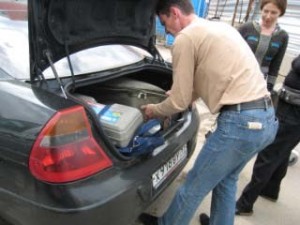 shipping costs here, for those who are curious. A good rule of thumb is start with the highest amount you think might be reasonable, and then double it. You then have some idea — provided you take the same number in Euros rather than dollars. You can look up the exchange for Euros yourself, I can’t bear to) . What can’t be shipped into Russia with your art are books, catalogues or advertising. Naturally, we have all kinds of art references that we need. Also we just published a beautiful brochure explaining the modern fine art tapestries that we specialize in (and which Julia translated into Russian). So we had to carry probably fifty pounds worth of printed material in our hand luggage. Nor do the Russian authorities allow tools to be shipped in either, so we have our hammers, staple guns and the like, in our suitcases!
shipping costs here, for those who are curious. A good rule of thumb is start with the highest amount you think might be reasonable, and then double it. You then have some idea — provided you take the same number in Euros rather than dollars. You can look up the exchange for Euros yourself, I can’t bear to) . What can’t be shipped into Russia with your art are books, catalogues or advertising. Naturally, we have all kinds of art references that we need. Also we just published a beautiful brochure explaining the modern fine art tapestries that we specialize in (and which Julia translated into Russian). So we had to carry probably fifty pounds worth of printed material in our hand luggage. Nor do the Russian authorities allow tools to be shipped in either, so we have our hammers, staple guns and the like, in our suitcases!
Now, you may have ideas about what to do when you arrive, jet-lagged by the 8 hour time difference and a fitful night on an airplane. Jane, being well-experienced in travel, has other ideas. The essential first thing is to establish communications (Napoleon, being a general, too, probably had similar ideas). So after checking into the hotel (a very nice Sheraton, even though they are doubling our rates for the first two nights because the soccer championships are in town and won’t give us any discounts, or even an upgrade), off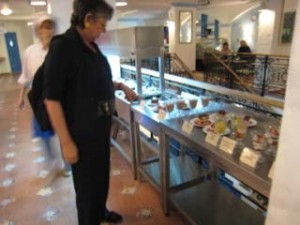 we went down Tverskaya Street in search of a phone store. Jane had told me to bring an old phone; we were going to buy a Russian sim card for it, and thus be able to talk to one another without phone through New York. This shows how smart Jane is — I had had the foresight to call TMobile and discovered that service to Russia is $5 per minute. Even if you don’t answer when it rings, you get charged $5.
we went down Tverskaya Street in search of a phone store. Jane had told me to bring an old phone; we were going to buy a Russian sim card for it, and thus be able to talk to one another without phone through New York. This shows how smart Jane is — I had had the foresight to call TMobile and discovered that service to Russia is $5 per minute. Even if you don’t answer when it rings, you get charged $5.
I’m not exactly sure why it took two hours to get these phone cards , but by this point I hadn’t eaten anything since the cereal and fruit on the plane — I don’t know if was at three o’clock in the morning or noon. I was seriously into what Arlene calls “the zone.” I am a bit of problem when I am in the zone, hunger drives me insane apparently. Julia was also in the zone, but she was merely weak. Jane didn’t seem seriously affected and kept trying to explain to the Russian clerk at the phone store exactly what she wanted in a phone card (Julia attempting to translate, simultaneously, as her eyeballs rotated back and forth in her skull). The fact that I immediately blew the fuses to every light in the room and shorted out the “laptop safe” upon arrival says something about our energy field.
By the time we got out of the store with our phone cards, I was gibbering in some alien tongue, Julia appeared to be sleepwalking. Jane tried her best to steer us to an appropriate restaurant. After rejecting twenty six, we stumbled into some kind of cafeteria, which I didn’t like the looks of at all (having gone to high school with a cafeteria and being naturally prejudiced against them). Also the food looked suspiciously Russian. But what did I know, being in the Zone? In fact everything was delicious and quite reasonably priced — for this unreasonably priced city.
I was feeling slightly more human by the time we got back to the hotel and went through the ordeal of trying to insert sim cards into our telephones for an unsuccessful hour. Today we will go back to the phone store and see if they can get the phones to work (the sim cards worked fine — the phones just woke up saying “RESTRICTED.”
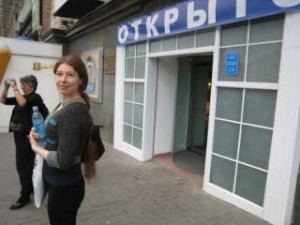 I bought an internet card before going upstairs (you don’t even want to know what this costs — and it will last only 24 hours – no discounts given if you need two weeks). The password seemed to be in Russian, so I couldn’t get on line before going to bed last night at nearly 9:00 pm. When I woke up my watch said 9:30, but it was still dark outside, so I went back to sleep. The next time I woke up, my watch said 9:15. It took me quite some time to figure what this all meant — by then I had paid $28 for a croissant and coffee. Maybe we can find some kind of Starbuckski affair near the hotel. I will keep you posted.
I bought an internet card before going upstairs (you don’t even want to know what this costs — and it will last only 24 hours – no discounts given if you need two weeks). The password seemed to be in Russian, so I couldn’t get on line before going to bed last night at nearly 9:00 pm. When I woke up my watch said 9:30, but it was still dark outside, so I went back to sleep. The next time I woke up, my watch said 9:15. It took me quite some time to figure what this all meant — by then I had paid $28 for a croissant and coffee. Maybe we can find some kind of Starbuckski affair near the hotel. I will keep you posted.
A final note — there are two thin English language newspapers and from them you really begin to understand how foreign a place this is. I sat next to a diplomat on the plane who explained to me how things worked in Moscow. The mayor apparently is intent on progress, so building regularly mysteriously burn down and miraculously reconstruction begins the next day. His wife apparently owns the company that supplies all the cement for this. The Manege — the 19th century riding academy where the Art Fair will take place — was one of these mysterious urban renewal miracles. Apparently facts on the ground rule development. If you want to do something, you act and then nobody can stop you in retrospect. The laws governing constructions were apparently all passed by this mayor, and even judges can’t figure out how to get around them.
One story yesterday that really caught my eye: “Institute Denies It Director Was Killed by Poison.” This was some big scientific institute, the director of which is a close friend of Vladimir Putin. His brother is a billionaire. The institute developed the Soviet Atomic Bomb and last year received a billion dollars to develop nanotechnology. So the story was that an envelope containing white powder, addressed to the director, was opened by his deputy. Five days later she fell sick and died of multiple organ failure. Russia’s chief public health officer declared the powder was harmless. Prosecutors have declined to open an investigation. A colleague of the deceased commented, “It was just an unlucky coincidence.”
Here are some more sights in Moscow — forgive me for dwelling on the familiar (besides Mamma Mia, Indiana Jones and a Karaoke Club, there’s also a Kentucky Fried Chicken place in there somewhere); i was in the zone
